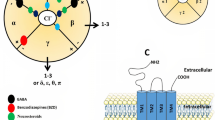Abstract
GABAA receptors are ligand-gated chloride ion channels composed of five subunits that can be opened by GABA, and modulated by multiple drugs, some of utmost clinical importance. GABAA receptors occur in the nervous system as well as in peripheral tissues where their function is largely unknown. The existence of multiple GABAA receptor subtypes with distinct subunit composition leads to multiple homologous binding sites with different degrees of similarity. Crystal structures of proteins homologous to GABAA receptors and of a GABAA receptor subtype, combined with homology modeling studies, have provided insights into the possible location of drug interaction sites. Some of these sites have been confirmed by experimental studies. For many receptor ligands, however, binding sites are not yet known. Here we will briefly review the function of distinct types of GABAA receptors and provide structural insights and experimental evidence on binding sites for ligands that could be of considerable clinical interest.


Similar content being viewed by others
Abbreviations
- nAChR:
-
nicotinic acetylcholine receptor
- AChBP:
-
acetylcholine binding protein
- GluCl:
-
glutamate-activated chloride channel
- 5-HT:
-
5- hydroxytryptamine (serotonin)
- GLIC:
-
Gloeobacter violaceus ligand-gated ion channel
- ELIC:
-
Erwinia chrysantemi ligand-gated ion channel
- ICD:
-
intracellular domain
- TM:
-
transmembrane
References
Sieghart W (2015) Allosteric modulation of GABAA receptors via multiple drug-binding sites. Adv Pharmacol 72:53–96
Rudolph U, Mohler H (2014) GABAA receptor subtypes: therapeutic potential in Down syndrome, affective disorders, schizophrenia, and autism. Annu Rev Pharmacol Toxicol 54:483–507
Brickley SG, Mody I (2012) Extrasynaptic GABA(A) receptors: their function in the CNS and implications for disease. Neuron 73(1):23–34
Gladkevich A et al (2006) The peripheral GABAergic system as a target in endocrine disorders. Auton Neurosci 124(1–2):1–8
Wan Y, Wang Q, Prud’homme GJ (2015) GABAergic system in the endocrine pancreas: a new target for diabetes treatment. Diabetes Metab Syndr Obes 8:79–87
Barragan A et al (2015) GABAergic signalling in the immune system. Acta Physiol (Oxf) 213(4):819–827
Gallos G et al (2015) Selective targeting of the alpha5-subunit of GABAA receptors relaxes airway smooth muscle and inhibits cellular calcium handling. Am J Physiol Lung Cell Mol Physiol 308(9):L931–L942
Brejc K et al (2001) Crystal structure of an ACh-binding protein reveals the ligand-binding domain of nicotinic receptors. Nature 411(6835):269–276
Richter L et al (2012) Diazepam-bound GABAA receptor models identify new benzodiazepine binding-site ligands. Nat Chem Biol 8(5):455–464
Miller PS, Aricescu AR (2014) Crystal structure of a human GABAA receptor. Nature 512(7514):270–275
Althoff T et al (2014) X-ray structures of GluCl in apo states reveal a gating mechanism of Cys-loop receptors. Nature 512(7514):333–337
Hansen SB et al (2005) Structures of Aplysia AChBP complexes with nicotinic agonists and antagonists reveal distinctive binding interfaces and conformations. EMBO J 24(20):3635–3646
Hassaine G et al (2014) X-ray structure of the mouse serotonin 5-HT3 receptor. Nature 512(7514):276–281
Hibbs RE, Gouaux E (2011) Principles of activation and permeation in an anion-selective Cys-loop receptor. Nature 474(7349):54–60
Spurny R et al (2015) Molecular blueprint of allosteric binding sites in a homologue of the agonist-binding domain of the alpha7 nicotinic acetylcholine receptor. Proc Natl Acad Sci U S A 112(19):E2543–E2552
Franks NP (2015) Structural comparisons of ligand-gated ion channels in open, closed, and desensitized states identify a novel propofol-binding site on mammalian gamma-aminobutyric acid type A receptors. Anesthesiology 122(4):787–794
Sieghart W, Karobath M (1980) Molecular heterogeneity of benzodiazepine receptors. Nature 286(5770):285–287
Olsen RW, Sieghart W (2008) International Union of Pharmacology. LXX. Subtypes of gamma-aminobutyric acid(A) receptors: classification on the basis of subunit composition, pharmacology, and function. Update. Pharmacol Rev 60(3):243–260
Acknowledgments
We gratefully acknowledge financial support by the Austrian Science Fund (Margot Ernst and Werner Sieghart) over many years as well as financial support by grants of the European Union to Werner Sieghart.
Author information
Authors and Affiliations
Corresponding author
Rights and permissions
About this article
Cite this article
Ernst, M., Sieghart, W. GABAA receptor subtypes: structural variety raises hope for new therapy concepts. e-Neuroforum 6, 97–103 (2015). https://doi.org/10.1007/s13295-015-0016-9
Published:
Issue Date:
DOI: https://doi.org/10.1007/s13295-015-0016-9




